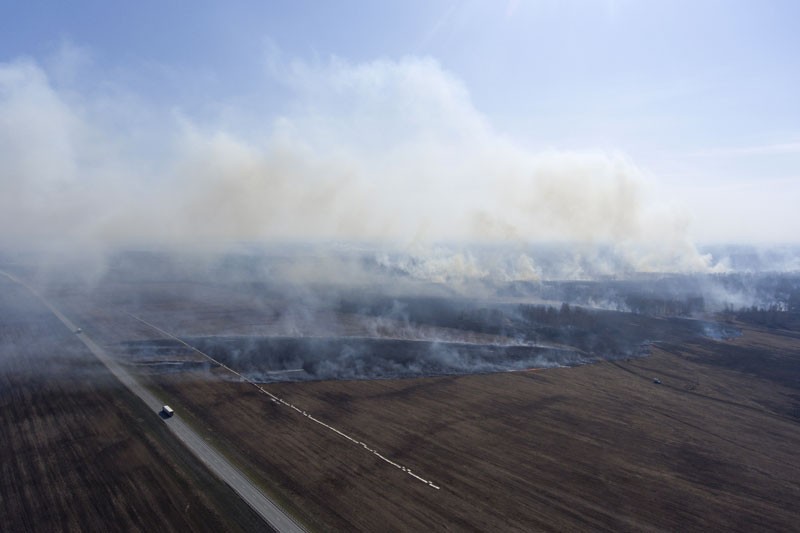Fires are releasing record levels of carbon dioxide, partly because they are burning ancient peatlands that have been a carbon sink.
 Northern fires (like the one shown here in the Novosibirsk region of south Siberia) released record-setting amounts of carbon dioxide this year.Credit: Kirill Kukhmar/TASS/Getty
Northern fires (like the one shown here in the Novosibirsk region of south Siberia) released record-setting amounts of carbon dioxide this year.Credit: Kirill Kukhmar/TASS/Getty
Wildfires blazed along the Arctic Circle this summer, incinerating tundra, blanketing Siberian cities in smoke and capping the second extraordinary fire season in a row. By the time the fire season waned at the end of last month, the blazes had emitted a record 244 megatonnes of carbon dioxide — that’s 35% more than last year, which also set records. One culprit, scientists say, could be peatlands that are burning as the top of the world melts.
Peatlands are carbon-rich soils that accumulate as waterlogged plants slowly decay, sometimes over thousands of years. They are the most carbon-dense ecosystems on Earth; a typical northern peatland packs in roughly ten times as much carbon as a boreal forest. When peat burns, it releases its ancient carbon to the atmosphere, adding to the heat-trapping gases that cause climate change.
Nearly half the world’s peatland-stored carbon lies between 60 and 70 degrees north, along the Arctic Circle. The problem with this is that historically frozen carbon-rich soils are expected to thaw as the planet warms, making them even more vulnerable to wildfires and more likely to release large amounts of carbon. It’s a feedback loop: as peatlands release more carbon, global warming increases, which thaws more peat and causes more wildfires (see ‘Peatlands burning’). A study published last month1 shows that northern peatlands could eventually shift from being a net sink for carbon to a net source of carbon, further accelerating climate change.
The unprecedented Arctic wildfires of 2019 and 2020 show that transformational shifts are already under way, says Thomas Smith, an environmental geographer at the London School of Economics and Political Science. “Alarming is the right term.”
Zombie fires
The fire season in the Arctic kicked off unusually early this year: as early as May, there were fires blazing north of the tree line in Siberia, which normally wouldn’t happen until around July. One reason is that temperatures in winter and spring were warmer than usual, priming the landscape to burn. It’s also possible that peat fires had been smouldering beneath the ice and snow all winter and then emerged, zombie-like, in the spring as the snow melted. Scientists have shown that this kind of low-temperature, flameless combustion can burn in peat and other organic matter, such as coal, for months or even years.
Because of the early start, individual Arctic wildfires have been burning for longer than usual, and “they’re starting much farther north than they used to — in landscapes that we thought were fire-resistant rather than fire-prone”, says Jessica McCarty, a geographer at Miami University in Oxford, Ohio.
Researchers are now assessing just how bad this Arctic fire season was. The Russian Wildfires Remote Monitoring System catalogued 18,591 separate fires in Russia’s two easternmost districts, with a total of nearly 14 million hectares burnt, says Evgeny Shvetsov, a fire specialist at the Sukachev Institute of Forest, which is part of the Russian Academy of Sciences in Krasnoyarsk. Most of the burning happened in permafrost zones, where the ground is normally frozen year-round.
To estimate the record carbon dioxide emissions, scientists with the European Commission’s Copernicus Atmosphere Monitoring Service used satellites to study the wildfires’ locations and intensity, and then calculated how much fuel each had probably burnt. Yet even that is likely to be an underestimate, says Mark Parrington, an atmospheric scientist at the European Centre for Medium-Range Weather Forecasts in Reading, UK, who was involved in the analysis. Fires that burn in peatland can be too low-intensity for satellite sensors to capture.
The problem with peat
How much this year’s Arctic fires will affect global climate over the long term depends on what they burnt. That’s because peatlands, unlike boreal forest, do not regrow quickly after a fire, so the carbon released is permanently lost to the atmosphere.
Smith has calculated that about half of the Arctic wildfires in May and June were on peatlands — and that in many cases, the fires went on for days, suggesting that they were fuelled by thick layers of peat or other soil rich in organic matter.
And the August study1 found that there are nearly four million square kilometres of peatlands in northern latitudes. More of that than previously thought is frozen and shallow — and therefore vulnerable to thawing and drying out, says Gustaf Hugelius, a permafrost scientist at Stockholm University who led the investigation. He and his colleagues also found that although peatlands have been helping to cool the climate for thousands of years, by storing carbon as they accumulate, they will probably become a net source of carbon being released into the atmosphere — which could happen by the end of the century.
Fire risk in Siberia is predicted to increase as the climate warms2, but by many measures, the shift has already arrived, says Amber Soja, an environmental scientist who studies Arctic fires at the US National Institute of Aerospace in Hampton, Virginia. “What you would expect is already happening,” she says. “And in some cases faster than we would have expected.”
(Source: Nature)












Đăng nhận xét